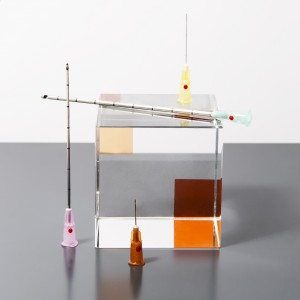Discover our new series of articles dedicated to each area of the body, this month SoftFil focuses on the use of the microcannula for the nasal area.
Medical rhinoplasty has become over time a real alternative to heavy surgical procedures for nose correction. There is no more need to endure surgery, anesthesia or postoperative care. Not only is this practice less painful, but the results are instantaneous and it offers satisfactory results thanks to the use of filling products such as hyaluronic acid.
- Why use a microcannula rather than a hypodermic needle for a medical rhinoplasty?

Surgical rhinoplasty involves a considerable amount of patient recovery time with temporary side effects and lengthy post-operative care. In comparison, a medical rhinoplasty has fewer risks and side effects. Erasing irregularities of the nose, reducing a bump or a hollow, correcting a deviation, refining a nose that is too wide or redrawing a faded bridge has become easy and quick, but not without risks. The nasal area is extremely sensitive and needs to be treated with great precision, perfect anatomical knowledge and the appropriate tools by aesthetic medicine professionals.
This operation is traditionally performed with the use of a sharp tipped hypodermic needle, which is certainly effective but also presents many risks that should not be overlooked by the professional. In order to better accompany the filling operation, the use of a microcannula is more advantageous than a traditional pointed-tip needle. In addition to their convenience and ease of injection of dermal filler, microcannulas protect the patient from many undesirable side effects.
With the help of an adapted microcannula, professionals are able to shape and fill in areas of the nose with precision. By inserting the microcannula into the targeted area, aesthetic doctors can lift or raise certain areas of the nose according to the patient’s wishes.

- The use of the microcannula is less dangerous and traumatic
The main feature of a microcannula is its blunt, round tip that is gentler and less traumatic for the patient. The overall design of the microcannula tip reduces damage and side effects to the skin, muscles and tissues during the injection process. This is because the blunt tip of a microcannula pushes through the dermal layer instead of piercing it like a traditional needle. This allows it to bypass important vascular systems and avoid overworking the skin by creating scars and wounds each time it is inserted. Less trauma to the skin means that the patient will be less likely to suffer from swelling, bruising, bleeding or inflammation than with a conventional needle. These advantages will also make it easier for the aesthetic physician to assess the effectiveness of the nasal procedure.
- A wider reach of injection
With only one point of entry required, aesthetic physicians have the freedom to fill most areas around the nose, especially the nasolabial folds with the STOP Facial Aging Method. Known to be a particularly difficult area to fill due to the sensitivity of the skin, the use of the microcannula helps to minimize the risks and overcome these limitations known by hypodermic needle users. Because the microcannulas can bend under the dermal layer, aesthetic physicians can easily reach any area around the nose from most adjacent sites on the face. - Better repartition of the dermal filler in the lines around the nose
The hypodermic needle can cause unexpected reactions during the injection process: a deposit of the filler in the wrong place or its displacement into a dangerous area during the procedure.Whereas the micro-cannula allows a better distribution of the filler and is easy to use.
By using an EasyGuide pre-hole needle in combination with a microcannula, such as the SoftFil Precision 25G40 and 25G50 microcannulas or our microcannula dedicated for hard-to-reach areas, SoftFil Precision 26G13 microcannula, it is easier for professionals to accurately insert fillers and achieve the shape desired by the patient. The final result is more harmonious, without discoloration, hematoma or dangerous side effects such as necrosis due to the fragile vascularization of the nose. Overall, microcannulas are more effective than hypodermic needles for injecting dermal fillers into the nasal area. There is less risk of pain, bruising and discoloration for the patient, resulting in better final satisfaction.SoftFil created the SoftFil Precision 26G13 micro-cannula with the aim of providing physicians with the most suitable tool for dangerous areas such as the nose and thus making aesthetic injections as safe as possible. Its length is specifically designed for insertion into the columella and injection up to the tip of the nose. Its caliber is ideally defined for injecting a reticulate product, optimizing the pushing force and thus avoiding vascular risks. Practical and movable in all angles, the SoftFil Precision 26G13 micro-cannula minimizes the risk of slipping and therefore avoids as much as possible the infectious problems so dreaded in this area. This micro-cannula is part of SoftFil’s global approach to develop as many tools as possible to secure the practice of aesthetic medicine for both practitioner and patient.
The final result is more harmonious, without discoloration, hematoma or dangerous side effects such as necrosis due to the fragile vascularization of the nose. Overall, microcannulas are more effective than hypodermic needles for injecting dermal fillers into the nasal area. There is less risk of pain, bruising and discoloration for the patient, resulting in better final satisfaction.SoftFil created the SoftFil Precision 26G13 micro-cannula with the aim of providing physicians with the most suitable tool for dangerous areas such as the nose and thus making aesthetic injections as safe as possible. Its length is specifically designed for insertion into the columella and injection up to the tip of the nose. Its caliber is ideally defined for injecting a reticulate product, optimizing the pushing force and thus avoiding vascular risks. Practical and movable in all angles, the SoftFil Precision 26G13 micro-cannula minimizes the risk of slipping and therefore avoids as much as possible the infectious problems so dreaded in this area. This micro-cannula is part of SoftFil’s global approach to develop as many tools as possible to secure the practice of aesthetic medicine for both practitioner and patient.
Become a microcannula pro with SoftFil Academy masterclasses!
Microcannulas are becoming the tool of choice for many aesthetic physicians for injection in the nose area. However, they need to be skilled at injecting and know the key areas to inject safely. You are interested in the efficiency of the microcannula but you don’t have enough experience? Don’t hesitate to sign up for the SoftFil Academy, our free online platform for learning how to use the cannula. For the more experienced, feel free to watch our complete video on the use of the microcannula with the STOP Facial Aging Method on the full face with explanations on the injection of the columella area.
Subscribe to our SoftFil Academy newsletter to be informed about the new dates of the next masterclasses! See you soon!


